Managing and Business Finances: SkyCity Entertainment Group Report
VerifiedAdded on 2022/11/30
|17
|3340
|181
Report
AI Summary
This report provides a comprehensive analysis of SkyCity Entertainment Group's financial management and business operations. It begins with an overview of the company's background, including its business segments and market presence in Australia and New Zealand. The report then delves into the principles of agency theory, identifying key stakeholders such as directors, employees, customers, and shareholders. Capital budgeting techniques, including IRR and NPV, are applied to assess project feasibility. Key Performance Indicators (KPIs) are analyzed through trend analysis, profitability ratios, and solvency/liquidity ratios. The report also assesses financial risk, comparing SkyCity's performance to competitors and NZX stocks. Furthermore, it explores the challenges of conducting global business, including country risks. Stakeholder engagement strategies are examined, focusing on communication with internal and external stakeholders. The report also addresses compliance with external and internal requirements, including regulations in the New Zealand market. Finally, it discusses the business knowledge needed to analyze financial information and the importance of social and ethical behavior in business practices. The report includes a detailed reference list and appendix.
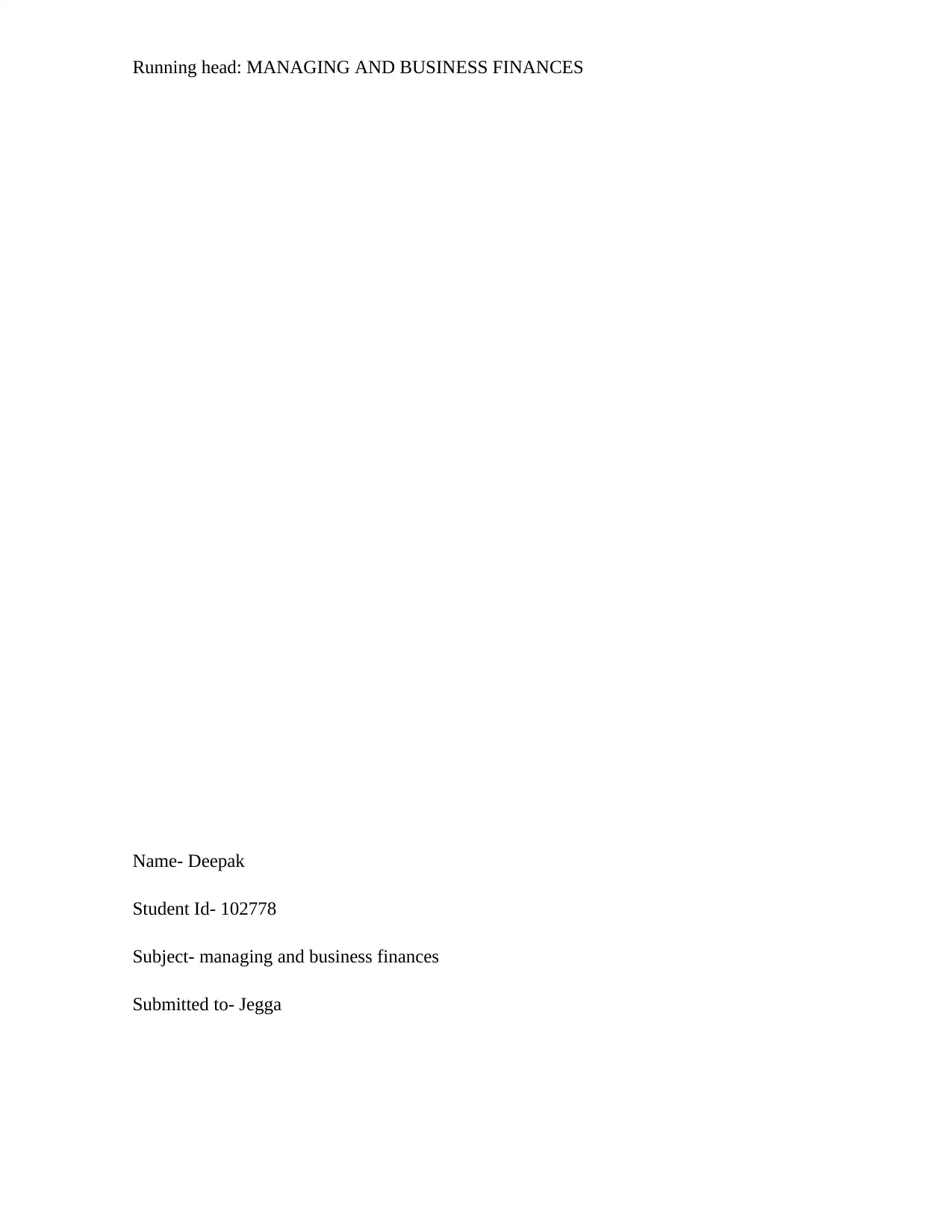
Running head: MANAGING AND BUSINESS FINANCES
Name- Deepak
Student Id- 102778
Subject- managing and business finances
Submitted to- Jegga
Name- Deepak
Student Id- 102778
Subject- managing and business finances
Submitted to- Jegga
Paraphrase This Document
Need a fresh take? Get an instant paraphrase of this document with our AI Paraphraser
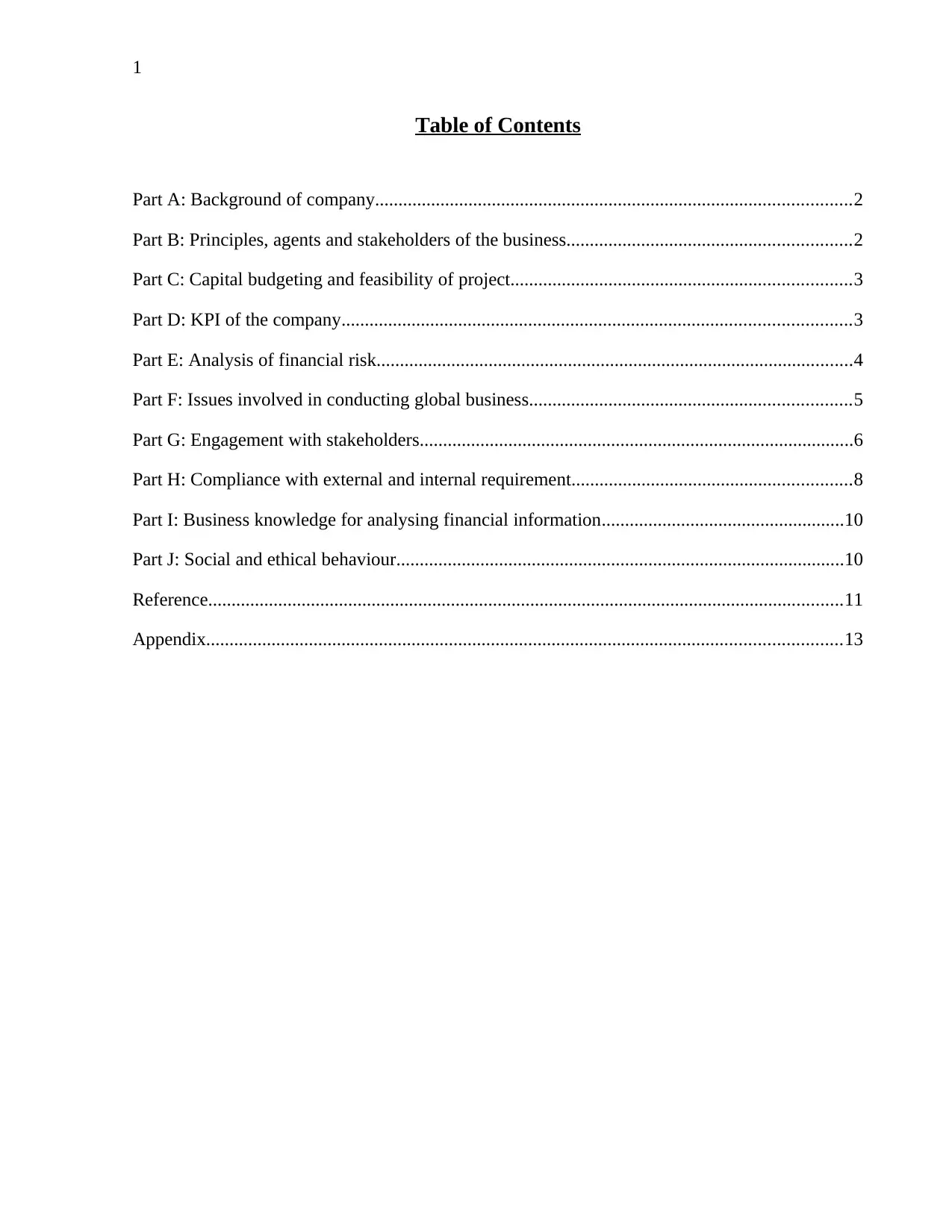
1
Table of Contents
Part A: Background of company......................................................................................................2
Part B: Principles, agents and stakeholders of the business.............................................................2
Part C: Capital budgeting and feasibility of project.........................................................................3
Part D: KPI of the company.............................................................................................................3
Part E: Analysis of financial risk......................................................................................................4
Part F: Issues involved in conducting global business.....................................................................5
Part G: Engagement with stakeholders.............................................................................................6
Part H: Compliance with external and internal requirement............................................................8
Part I: Business knowledge for analysing financial information....................................................10
Part J: Social and ethical behaviour................................................................................................10
Reference........................................................................................................................................11
Appendix........................................................................................................................................13
Table of Contents
Part A: Background of company......................................................................................................2
Part B: Principles, agents and stakeholders of the business.............................................................2
Part C: Capital budgeting and feasibility of project.........................................................................3
Part D: KPI of the company.............................................................................................................3
Part E: Analysis of financial risk......................................................................................................4
Part F: Issues involved in conducting global business.....................................................................5
Part G: Engagement with stakeholders.............................................................................................6
Part H: Compliance with external and internal requirement............................................................8
Part I: Business knowledge for analysing financial information....................................................10
Part J: Social and ethical behaviour................................................................................................10
Reference........................................................................................................................................11
Appendix........................................................................................................................................13
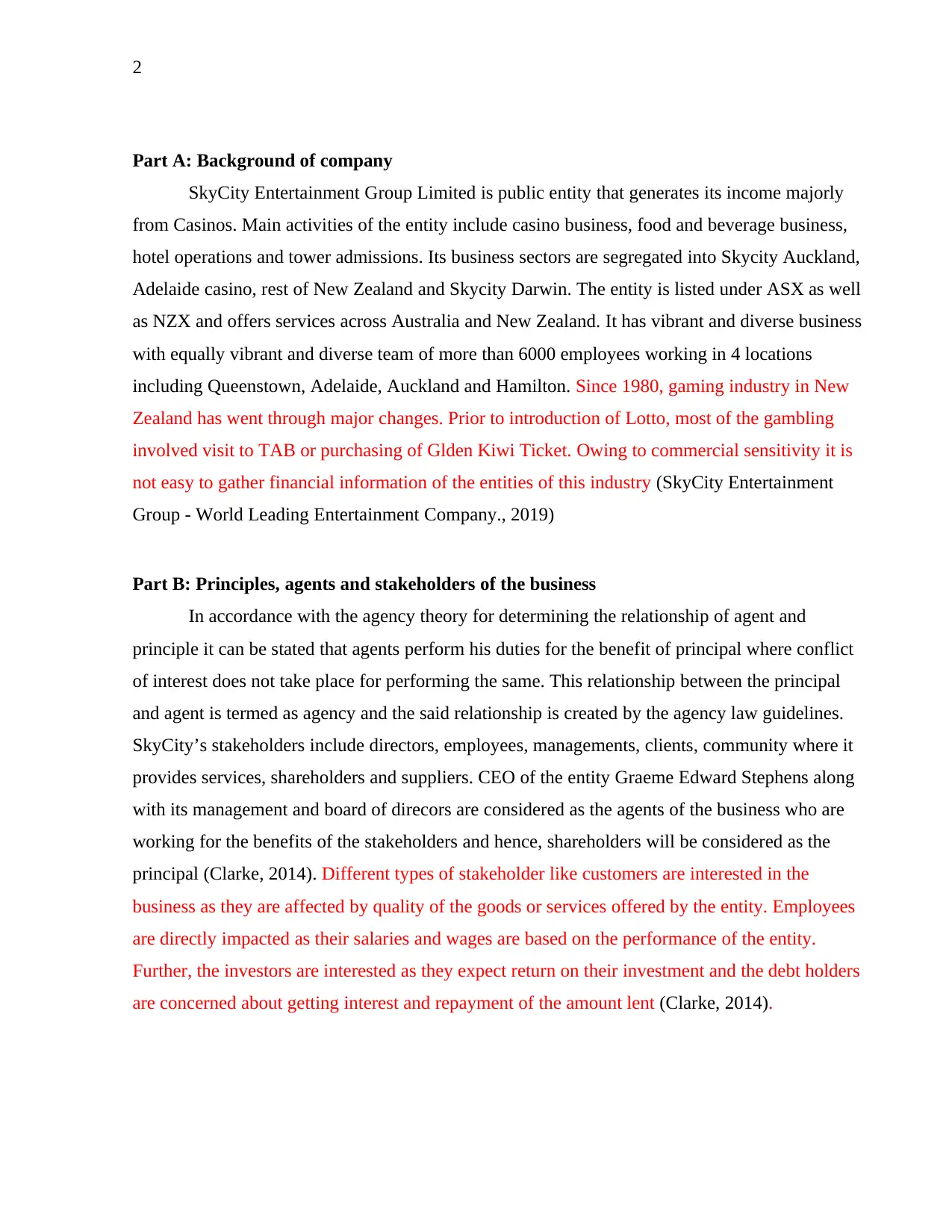
2
Part A: Background of company
SkyCity Entertainment Group Limited is public entity that generates its income majorly
from Casinos. Main activities of the entity include casino business, food and beverage business,
hotel operations and tower admissions. Its business sectors are segregated into Skycity Auckland,
Adelaide casino, rest of New Zealand and Skycity Darwin. The entity is listed under ASX as well
as NZX and offers services across Australia and New Zealand. It has vibrant and diverse business
with equally vibrant and diverse team of more than 6000 employees working in 4 locations
including Queenstown, Adelaide, Auckland and Hamilton. Since 1980, gaming industry in New
Zealand has went through major changes. Prior to introduction of Lotto, most of the gambling
involved visit to TAB or purchasing of Glden Kiwi Ticket. Owing to commercial sensitivity it is
not easy to gather financial information of the entities of this industry (SkyCity Entertainment
Group - World Leading Entertainment Company., 2019)
Part B: Principles, agents and stakeholders of the business
In accordance with the agency theory for determining the relationship of agent and
principle it can be stated that agents perform his duties for the benefit of principal where conflict
of interest does not take place for performing the same. This relationship between the principal
and agent is termed as agency and the said relationship is created by the agency law guidelines.
SkyCity’s stakeholders include directors, employees, managements, clients, community where it
provides services, shareholders and suppliers. CEO of the entity Graeme Edward Stephens along
with its management and board of direcors are considered as the agents of the business who are
working for the benefits of the stakeholders and hence, shareholders will be considered as the
principal (Clarke, 2014). Different types of stakeholder like customers are interested in the
business as they are affected by quality of the goods or services offered by the entity. Employees
are directly impacted as their salaries and wages are based on the performance of the entity.
Further, the investors are interested as they expect return on their investment and the debt holders
are concerned about getting interest and repayment of the amount lent (Clarke, 2014).
Part A: Background of company
SkyCity Entertainment Group Limited is public entity that generates its income majorly
from Casinos. Main activities of the entity include casino business, food and beverage business,
hotel operations and tower admissions. Its business sectors are segregated into Skycity Auckland,
Adelaide casino, rest of New Zealand and Skycity Darwin. The entity is listed under ASX as well
as NZX and offers services across Australia and New Zealand. It has vibrant and diverse business
with equally vibrant and diverse team of more than 6000 employees working in 4 locations
including Queenstown, Adelaide, Auckland and Hamilton. Since 1980, gaming industry in New
Zealand has went through major changes. Prior to introduction of Lotto, most of the gambling
involved visit to TAB or purchasing of Glden Kiwi Ticket. Owing to commercial sensitivity it is
not easy to gather financial information of the entities of this industry (SkyCity Entertainment
Group - World Leading Entertainment Company., 2019)
Part B: Principles, agents and stakeholders of the business
In accordance with the agency theory for determining the relationship of agent and
principle it can be stated that agents perform his duties for the benefit of principal where conflict
of interest does not take place for performing the same. This relationship between the principal
and agent is termed as agency and the said relationship is created by the agency law guidelines.
SkyCity’s stakeholders include directors, employees, managements, clients, community where it
provides services, shareholders and suppliers. CEO of the entity Graeme Edward Stephens along
with its management and board of direcors are considered as the agents of the business who are
working for the benefits of the stakeholders and hence, shareholders will be considered as the
principal (Clarke, 2014). Different types of stakeholder like customers are interested in the
business as they are affected by quality of the goods or services offered by the entity. Employees
are directly impacted as their salaries and wages are based on the performance of the entity.
Further, the investors are interested as they expect return on their investment and the debt holders
are concerned about getting interest and repayment of the amount lent (Clarke, 2014).
⊘ This is a preview!⊘
Do you want full access?
Subscribe today to unlock all pages.

Trusted by 1+ million students worldwide
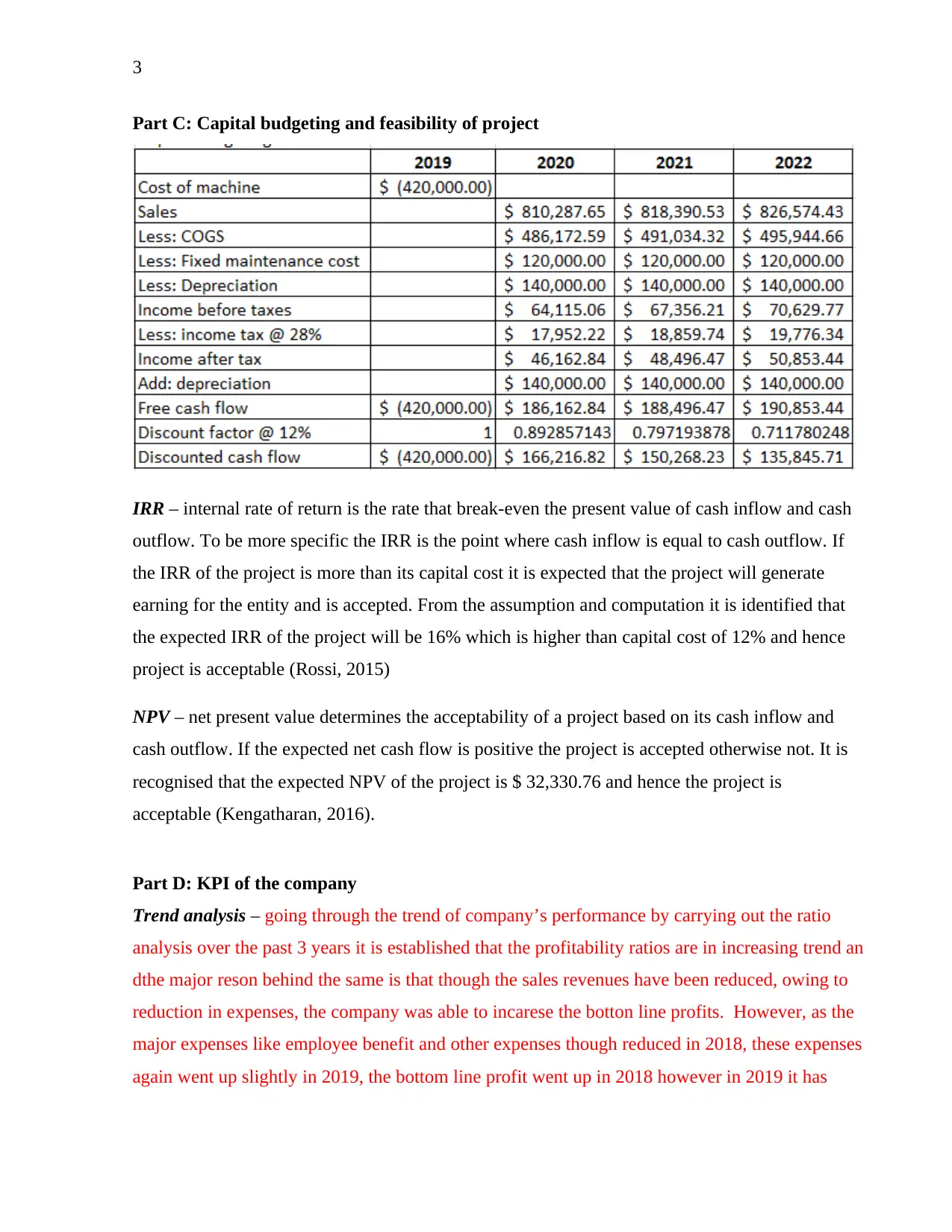
3
Part C: Capital budgeting and feasibility of project
IRR – internal rate of return is the rate that break-even the present value of cash inflow and cash
outflow. To be more specific the IRR is the point where cash inflow is equal to cash outflow. If
the IRR of the project is more than its capital cost it is expected that the project will generate
earning for the entity and is accepted. From the assumption and computation it is identified that
the expected IRR of the project will be 16% which is higher than capital cost of 12% and hence
project is acceptable (Rossi, 2015)
NPV – net present value determines the acceptability of a project based on its cash inflow and
cash outflow. If the expected net cash flow is positive the project is accepted otherwise not. It is
recognised that the expected NPV of the project is $ 32,330.76 and hence the project is
acceptable (Kengatharan, 2016).
Part D: KPI of the company
Trend analysis – going through the trend of company’s performance by carrying out the ratio
analysis over the past 3 years it is established that the profitability ratios are in increasing trend an
dthe major reson behind the same is that though the sales revenues have been reduced, owing to
reduction in expenses, the company was able to incarese the botton line profits. However, as the
major expenses like employee benefit and other expenses though reduced in 2018, these expenses
again went up slightly in 2019, the bottom line profit went up in 2018 however in 2019 it has
Part C: Capital budgeting and feasibility of project
IRR – internal rate of return is the rate that break-even the present value of cash inflow and cash
outflow. To be more specific the IRR is the point where cash inflow is equal to cash outflow. If
the IRR of the project is more than its capital cost it is expected that the project will generate
earning for the entity and is accepted. From the assumption and computation it is identified that
the expected IRR of the project will be 16% which is higher than capital cost of 12% and hence
project is acceptable (Rossi, 2015)
NPV – net present value determines the acceptability of a project based on its cash inflow and
cash outflow. If the expected net cash flow is positive the project is accepted otherwise not. It is
recognised that the expected NPV of the project is $ 32,330.76 and hence the project is
acceptable (Kengatharan, 2016).
Part D: KPI of the company
Trend analysis – going through the trend of company’s performance by carrying out the ratio
analysis over the past 3 years it is established that the profitability ratios are in increasing trend an
dthe major reson behind the same is that though the sales revenues have been reduced, owing to
reduction in expenses, the company was able to incarese the botton line profits. However, as the
major expenses like employee benefit and other expenses though reduced in 2018, these expenses
again went up slightly in 2019, the bottom line profit went up in 2018 however in 2019 it has
Paraphrase This Document
Need a fresh take? Get an instant paraphrase of this document with our AI Paraphraser
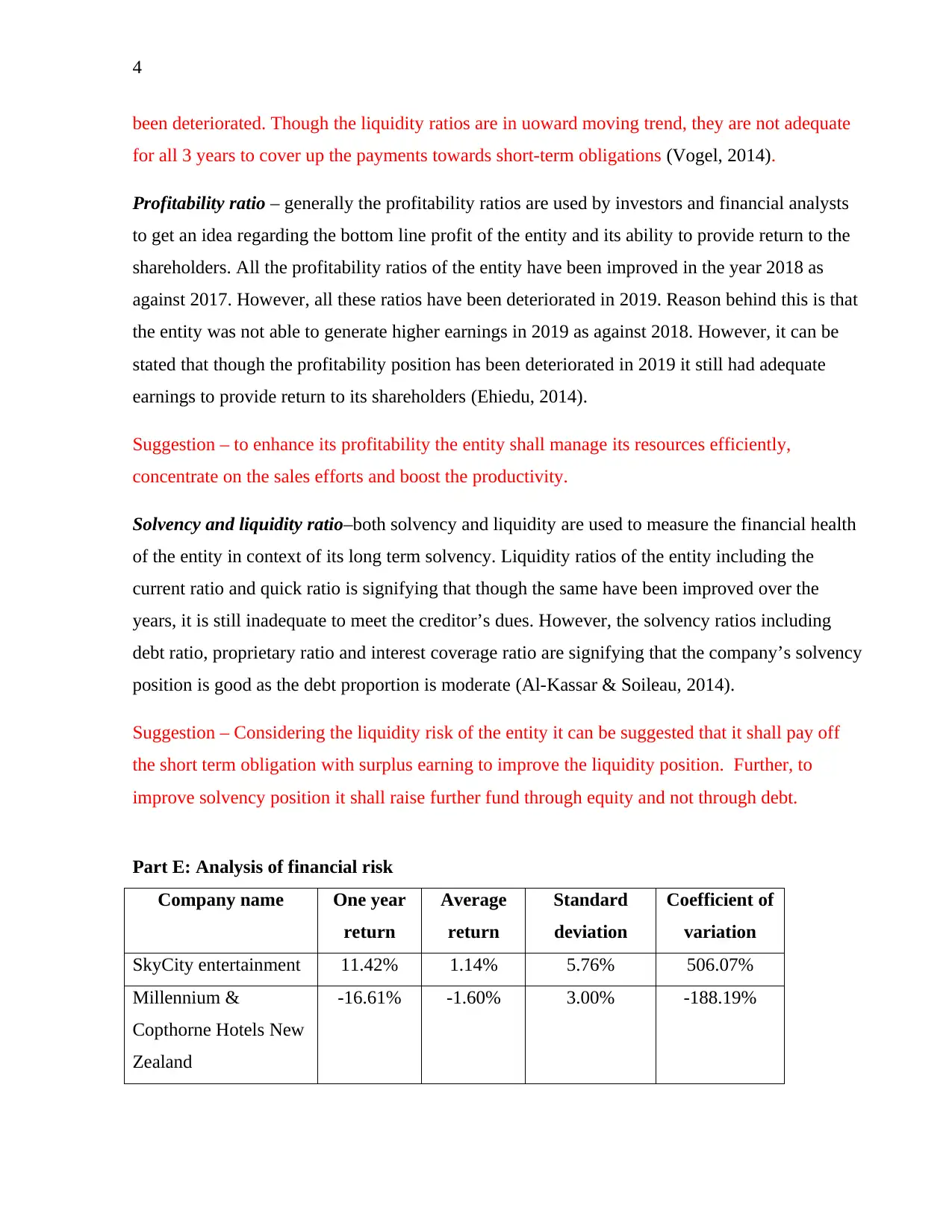
4
been deteriorated. Though the liquidity ratios are in uoward moving trend, they are not adequate
for all 3 years to cover up the payments towards short-term obligations (Vogel, 2014).
Profitability ratio – generally the profitability ratios are used by investors and financial analysts
to get an idea regarding the bottom line profit of the entity and its ability to provide return to the
shareholders. All the profitability ratios of the entity have been improved in the year 2018 as
against 2017. However, all these ratios have been deteriorated in 2019. Reason behind this is that
the entity was not able to generate higher earnings in 2019 as against 2018. However, it can be
stated that though the profitability position has been deteriorated in 2019 it still had adequate
earnings to provide return to its shareholders (Ehiedu, 2014).
Suggestion – to enhance its profitability the entity shall manage its resources efficiently,
concentrate on the sales efforts and boost the productivity.
Solvency and liquidity ratio–both solvency and liquidity are used to measure the financial health
of the entity in context of its long term solvency. Liquidity ratios of the entity including the
current ratio and quick ratio is signifying that though the same have been improved over the
years, it is still inadequate to meet the creditor’s dues. However, the solvency ratios including
debt ratio, proprietary ratio and interest coverage ratio are signifying that the company’s solvency
position is good as the debt proportion is moderate (Al-Kassar & Soileau, 2014).
Suggestion – Considering the liquidity risk of the entity it can be suggested that it shall pay off
the short term obligation with surplus earning to improve the liquidity position. Further, to
improve solvency position it shall raise further fund through equity and not through debt.
Part E: Analysis of financial risk
Company name One year
return
Average
return
Standard
deviation
Coefficient of
variation
SkyCity entertainment 11.42% 1.14% 5.76% 506.07%
Millennium &
Copthorne Hotels New
Zealand
-16.61% -1.60% 3.00% -188.19%
been deteriorated. Though the liquidity ratios are in uoward moving trend, they are not adequate
for all 3 years to cover up the payments towards short-term obligations (Vogel, 2014).
Profitability ratio – generally the profitability ratios are used by investors and financial analysts
to get an idea regarding the bottom line profit of the entity and its ability to provide return to the
shareholders. All the profitability ratios of the entity have been improved in the year 2018 as
against 2017. However, all these ratios have been deteriorated in 2019. Reason behind this is that
the entity was not able to generate higher earnings in 2019 as against 2018. However, it can be
stated that though the profitability position has been deteriorated in 2019 it still had adequate
earnings to provide return to its shareholders (Ehiedu, 2014).
Suggestion – to enhance its profitability the entity shall manage its resources efficiently,
concentrate on the sales efforts and boost the productivity.
Solvency and liquidity ratio–both solvency and liquidity are used to measure the financial health
of the entity in context of its long term solvency. Liquidity ratios of the entity including the
current ratio and quick ratio is signifying that though the same have been improved over the
years, it is still inadequate to meet the creditor’s dues. However, the solvency ratios including
debt ratio, proprietary ratio and interest coverage ratio are signifying that the company’s solvency
position is good as the debt proportion is moderate (Al-Kassar & Soileau, 2014).
Suggestion – Considering the liquidity risk of the entity it can be suggested that it shall pay off
the short term obligation with surplus earning to improve the liquidity position. Further, to
improve solvency position it shall raise further fund through equity and not through debt.
Part E: Analysis of financial risk
Company name One year
return
Average
return
Standard
deviation
Coefficient of
variation
SkyCity entertainment 11.42% 1.14% 5.76% 506.07%
Millennium &
Copthorne Hotels New
Zealand
-16.61% -1.60% 3.00% -188.19%
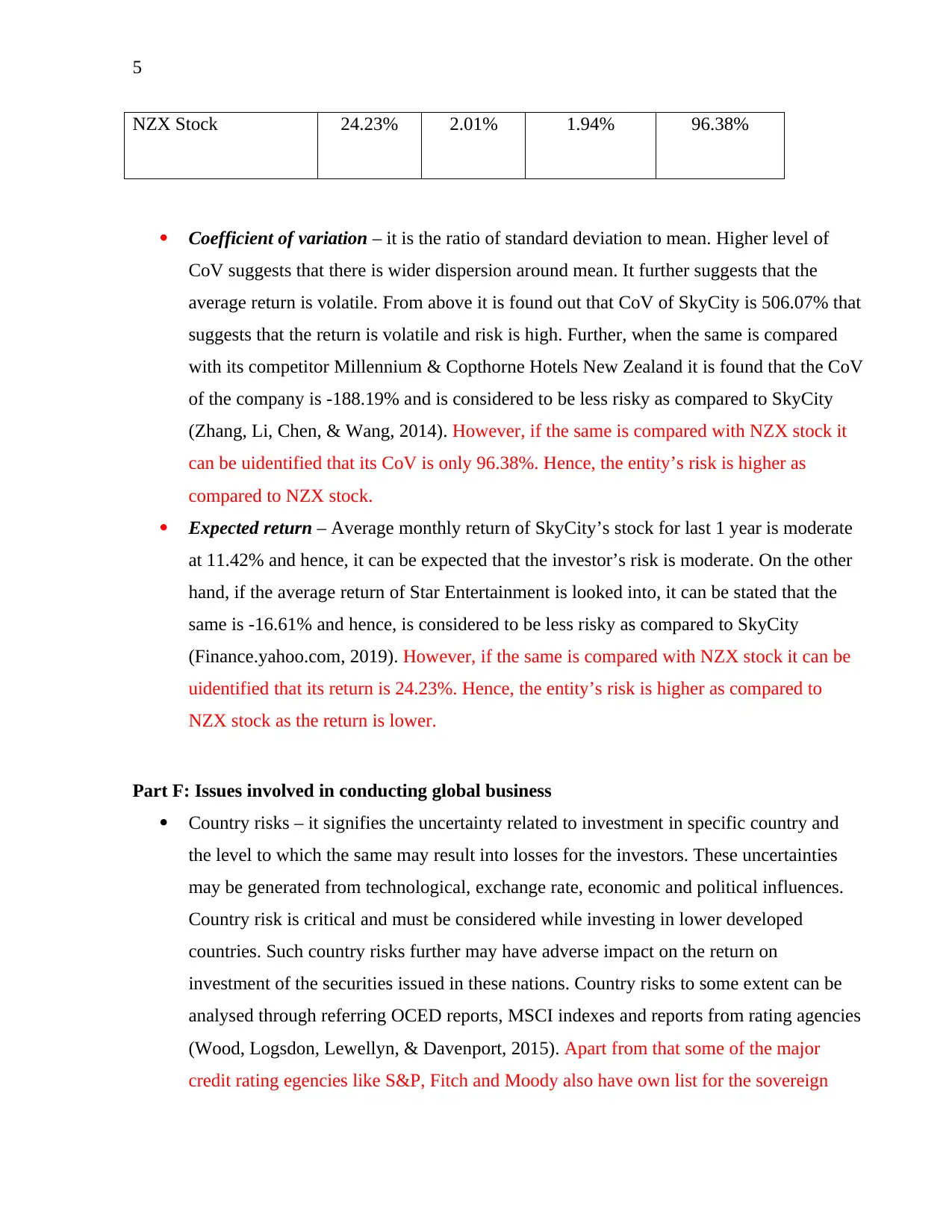
5
NZX Stock 24.23% 2.01% 1.94% 96.38%
Coefficient of variation – it is the ratio of standard deviation to mean. Higher level of
CoV suggests that there is wider dispersion around mean. It further suggests that the
average return is volatile. From above it is found out that CoV of SkyCity is 506.07% that
suggests that the return is volatile and risk is high. Further, when the same is compared
with its competitor Millennium & Copthorne Hotels New Zealand it is found that the CoV
of the company is -188.19% and is considered to be less risky as compared to SkyCity
(Zhang, Li, Chen, & Wang, 2014). However, if the same is compared with NZX stock it
can be uidentified that its CoV is only 96.38%. Hence, the entity’s risk is higher as
compared to NZX stock.
Expected return – Average monthly return of SkyCity’s stock for last 1 year is moderate
at 11.42% and hence, it can be expected that the investor’s risk is moderate. On the other
hand, if the average return of Star Entertainment is looked into, it can be stated that the
same is -16.61% and hence, is considered to be less risky as compared to SkyCity
(Finance.yahoo.com, 2019). However, if the same is compared with NZX stock it can be
uidentified that its return is 24.23%. Hence, the entity’s risk is higher as compared to
NZX stock as the return is lower.
Part F: Issues involved in conducting global business
Country risks – it signifies the uncertainty related to investment in specific country and
the level to which the same may result into losses for the investors. These uncertainties
may be generated from technological, exchange rate, economic and political influences.
Country risk is critical and must be considered while investing in lower developed
countries. Such country risks further may have adverse impact on the return on
investment of the securities issued in these nations. Country risks to some extent can be
analysed through referring OCED reports, MSCI indexes and reports from rating agencies
(Wood, Logsdon, Lewellyn, & Davenport, 2015). Apart from that some of the major
credit rating egencies like S&P, Fitch and Moody also have own list for the sovereign
NZX Stock 24.23% 2.01% 1.94% 96.38%
Coefficient of variation – it is the ratio of standard deviation to mean. Higher level of
CoV suggests that there is wider dispersion around mean. It further suggests that the
average return is volatile. From above it is found out that CoV of SkyCity is 506.07% that
suggests that the return is volatile and risk is high. Further, when the same is compared
with its competitor Millennium & Copthorne Hotels New Zealand it is found that the CoV
of the company is -188.19% and is considered to be less risky as compared to SkyCity
(Zhang, Li, Chen, & Wang, 2014). However, if the same is compared with NZX stock it
can be uidentified that its CoV is only 96.38%. Hence, the entity’s risk is higher as
compared to NZX stock.
Expected return – Average monthly return of SkyCity’s stock for last 1 year is moderate
at 11.42% and hence, it can be expected that the investor’s risk is moderate. On the other
hand, if the average return of Star Entertainment is looked into, it can be stated that the
same is -16.61% and hence, is considered to be less risky as compared to SkyCity
(Finance.yahoo.com, 2019). However, if the same is compared with NZX stock it can be
uidentified that its return is 24.23%. Hence, the entity’s risk is higher as compared to
NZX stock as the return is lower.
Part F: Issues involved in conducting global business
Country risks – it signifies the uncertainty related to investment in specific country and
the level to which the same may result into losses for the investors. These uncertainties
may be generated from technological, exchange rate, economic and political influences.
Country risk is critical and must be considered while investing in lower developed
countries. Such country risks further may have adverse impact on the return on
investment of the securities issued in these nations. Country risks to some extent can be
analysed through referring OCED reports, MSCI indexes and reports from rating agencies
(Wood, Logsdon, Lewellyn, & Davenport, 2015). Apart from that some of the major
credit rating egencies like S&P, Fitch and Moody also have own list for the sovereign
⊘ This is a preview!⊘
Do you want full access?
Subscribe today to unlock all pages.

Trusted by 1+ million students worldwide
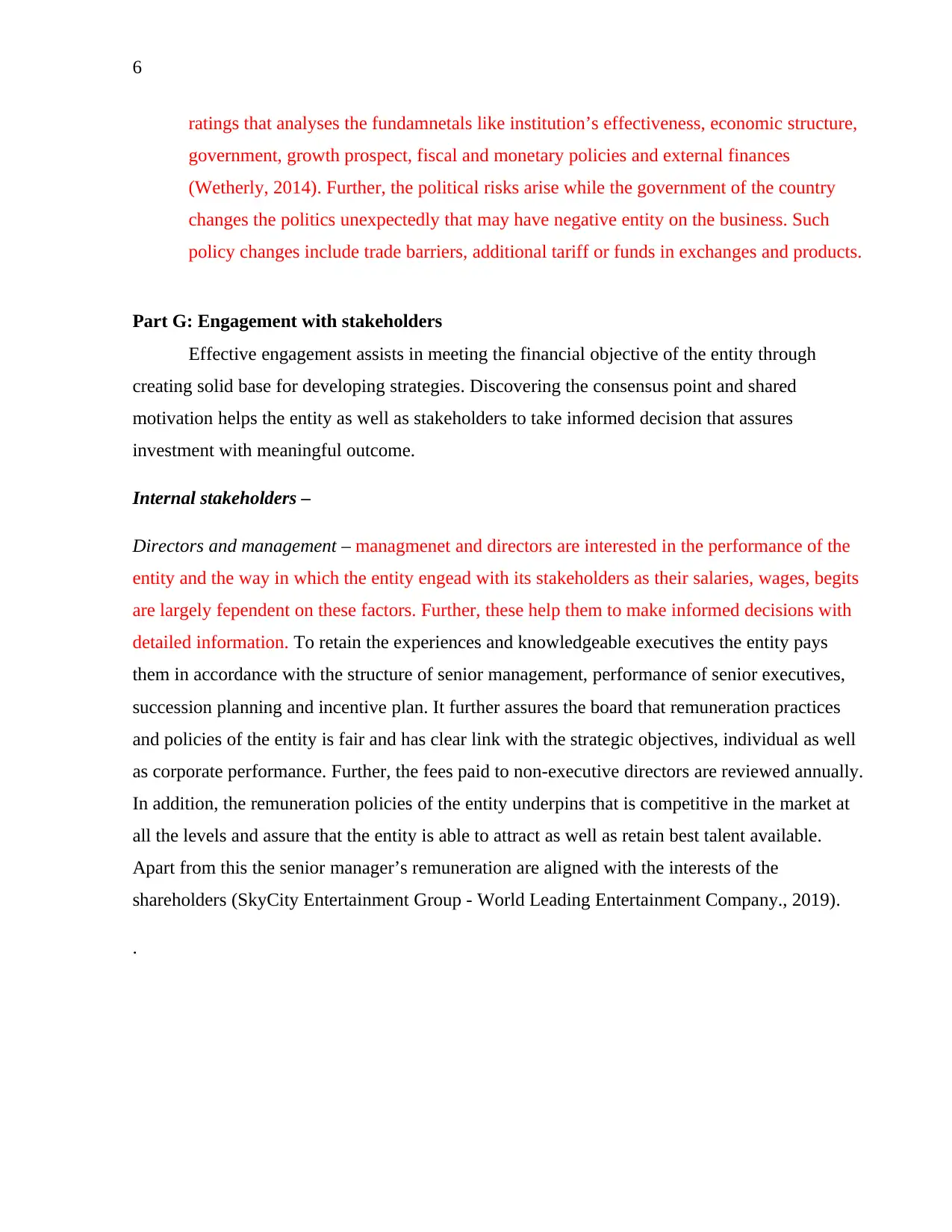
6
ratings that analyses the fundamnetals like institution’s effectiveness, economic structure,
government, growth prospect, fiscal and monetary policies and external finances
(Wetherly, 2014). Further, the political risks arise while the government of the country
changes the politics unexpectedly that may have negative entity on the business. Such
policy changes include trade barriers, additional tariff or funds in exchanges and products.
Part G: Engagement with stakeholders
Effective engagement assists in meeting the financial objective of the entity through
creating solid base for developing strategies. Discovering the consensus point and shared
motivation helps the entity as well as stakeholders to take informed decision that assures
investment with meaningful outcome.
Internal stakeholders –
Directors and management – managmenet and directors are interested in the performance of the
entity and the way in which the entity engead with its stakeholders as their salaries, wages, begits
are largely fependent on these factors. Further, these help them to make informed decisions with
detailed information. To retain the experiences and knowledgeable executives the entity pays
them in accordance with the structure of senior management, performance of senior executives,
succession planning and incentive plan. It further assures the board that remuneration practices
and policies of the entity is fair and has clear link with the strategic objectives, individual as well
as corporate performance. Further, the fees paid to non-executive directors are reviewed annually.
In addition, the remuneration policies of the entity underpins that is competitive in the market at
all the levels and assure that the entity is able to attract as well as retain best talent available.
Apart from this the senior manager’s remuneration are aligned with the interests of the
shareholders (SkyCity Entertainment Group - World Leading Entertainment Company., 2019).
.
ratings that analyses the fundamnetals like institution’s effectiveness, economic structure,
government, growth prospect, fiscal and monetary policies and external finances
(Wetherly, 2014). Further, the political risks arise while the government of the country
changes the politics unexpectedly that may have negative entity on the business. Such
policy changes include trade barriers, additional tariff or funds in exchanges and products.
Part G: Engagement with stakeholders
Effective engagement assists in meeting the financial objective of the entity through
creating solid base for developing strategies. Discovering the consensus point and shared
motivation helps the entity as well as stakeholders to take informed decision that assures
investment with meaningful outcome.
Internal stakeholders –
Directors and management – managmenet and directors are interested in the performance of the
entity and the way in which the entity engead with its stakeholders as their salaries, wages, begits
are largely fependent on these factors. Further, these help them to make informed decisions with
detailed information. To retain the experiences and knowledgeable executives the entity pays
them in accordance with the structure of senior management, performance of senior executives,
succession planning and incentive plan. It further assures the board that remuneration practices
and policies of the entity is fair and has clear link with the strategic objectives, individual as well
as corporate performance. Further, the fees paid to non-executive directors are reviewed annually.
In addition, the remuneration policies of the entity underpins that is competitive in the market at
all the levels and assure that the entity is able to attract as well as retain best talent available.
Apart from this the senior manager’s remuneration are aligned with the interests of the
shareholders (SkyCity Entertainment Group - World Leading Entertainment Company., 2019).
.
Paraphrase This Document
Need a fresh take? Get an instant paraphrase of this document with our AI Paraphraser
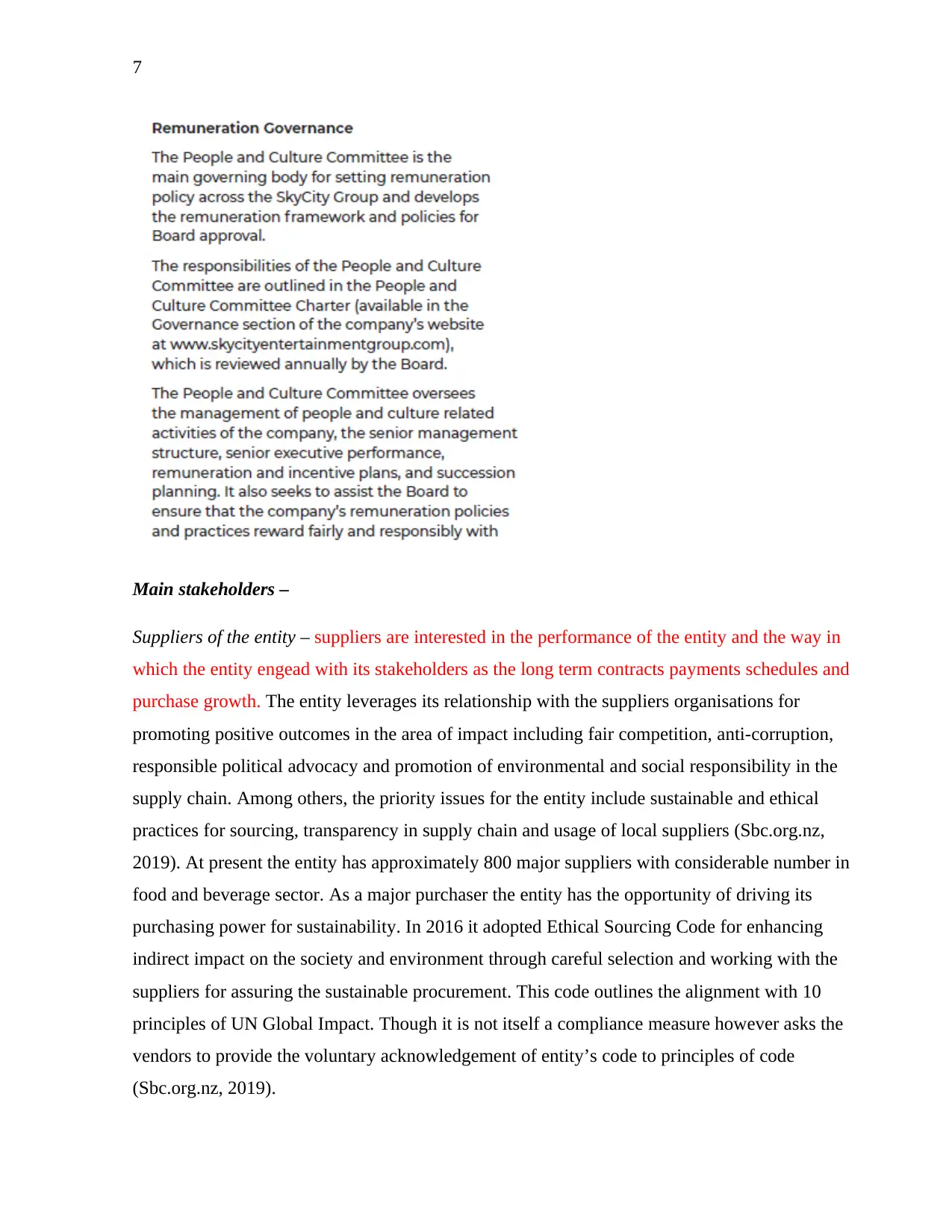
7
Main stakeholders –
Suppliers of the entity – suppliers are interested in the performance of the entity and the way in
which the entity engead with its stakeholders as the long term contracts payments schedules and
purchase growth. The entity leverages its relationship with the suppliers organisations for
promoting positive outcomes in the area of impact including fair competition, anti-corruption,
responsible political advocacy and promotion of environmental and social responsibility in the
supply chain. Among others, the priority issues for the entity include sustainable and ethical
practices for sourcing, transparency in supply chain and usage of local suppliers (Sbc.org.nz,
2019). At present the entity has approximately 800 major suppliers with considerable number in
food and beverage sector. As a major purchaser the entity has the opportunity of driving its
purchasing power for sustainability. In 2016 it adopted Ethical Sourcing Code for enhancing
indirect impact on the society and environment through careful selection and working with the
suppliers for assuring the sustainable procurement. This code outlines the alignment with 10
principles of UN Global Impact. Though it is not itself a compliance measure however asks the
vendors to provide the voluntary acknowledgement of entity’s code to principles of code
(Sbc.org.nz, 2019).
Main stakeholders –
Suppliers of the entity – suppliers are interested in the performance of the entity and the way in
which the entity engead with its stakeholders as the long term contracts payments schedules and
purchase growth. The entity leverages its relationship with the suppliers organisations for
promoting positive outcomes in the area of impact including fair competition, anti-corruption,
responsible political advocacy and promotion of environmental and social responsibility in the
supply chain. Among others, the priority issues for the entity include sustainable and ethical
practices for sourcing, transparency in supply chain and usage of local suppliers (Sbc.org.nz,
2019). At present the entity has approximately 800 major suppliers with considerable number in
food and beverage sector. As a major purchaser the entity has the opportunity of driving its
purchasing power for sustainability. In 2016 it adopted Ethical Sourcing Code for enhancing
indirect impact on the society and environment through careful selection and working with the
suppliers for assuring the sustainable procurement. This code outlines the alignment with 10
principles of UN Global Impact. Though it is not itself a compliance measure however asks the
vendors to provide the voluntary acknowledgement of entity’s code to principles of code
(Sbc.org.nz, 2019).
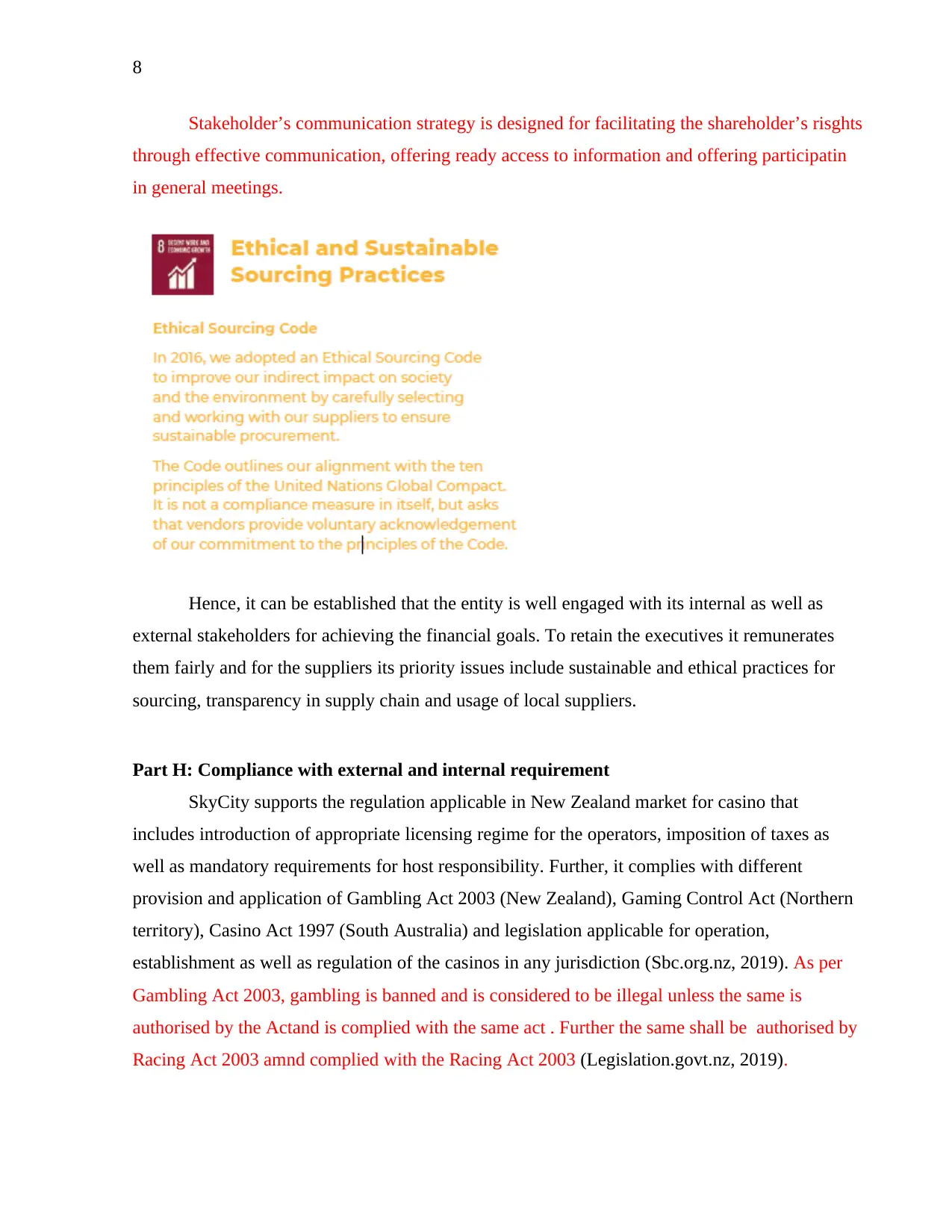
8
Stakeholder’s communication strategy is designed for facilitating the shareholder’s risghts
through effective communication, offering ready access to information and offering participatin
in general meetings.
Hence, it can be established that the entity is well engaged with its internal as well as
external stakeholders for achieving the financial goals. To retain the executives it remunerates
them fairly and for the suppliers its priority issues include sustainable and ethical practices for
sourcing, transparency in supply chain and usage of local suppliers.
Part H: Compliance with external and internal requirement
SkyCity supports the regulation applicable in New Zealand market for casino that
includes introduction of appropriate licensing regime for the operators, imposition of taxes as
well as mandatory requirements for host responsibility. Further, it complies with different
provision and application of Gambling Act 2003 (New Zealand), Gaming Control Act (Northern
territory), Casino Act 1997 (South Australia) and legislation applicable for operation,
establishment as well as regulation of the casinos in any jurisdiction (Sbc.org.nz, 2019). As per
Gambling Act 2003, gambling is banned and is considered to be illegal unless the same is
authorised by the Actand is complied with the same act . Further the same shall be authorised by
Racing Act 2003 amnd complied with the Racing Act 2003 (Legislation.govt.nz, 2019).
Stakeholder’s communication strategy is designed for facilitating the shareholder’s risghts
through effective communication, offering ready access to information and offering participatin
in general meetings.
Hence, it can be established that the entity is well engaged with its internal as well as
external stakeholders for achieving the financial goals. To retain the executives it remunerates
them fairly and for the suppliers its priority issues include sustainable and ethical practices for
sourcing, transparency in supply chain and usage of local suppliers.
Part H: Compliance with external and internal requirement
SkyCity supports the regulation applicable in New Zealand market for casino that
includes introduction of appropriate licensing regime for the operators, imposition of taxes as
well as mandatory requirements for host responsibility. Further, it complies with different
provision and application of Gambling Act 2003 (New Zealand), Gaming Control Act (Northern
territory), Casino Act 1997 (South Australia) and legislation applicable for operation,
establishment as well as regulation of the casinos in any jurisdiction (Sbc.org.nz, 2019). As per
Gambling Act 2003, gambling is banned and is considered to be illegal unless the same is
authorised by the Actand is complied with the same act . Further the same shall be authorised by
Racing Act 2003 amnd complied with the Racing Act 2003 (Legislation.govt.nz, 2019).
⊘ This is a preview!⊘
Do you want full access?
Subscribe today to unlock all pages.

Trusted by 1+ million students worldwide
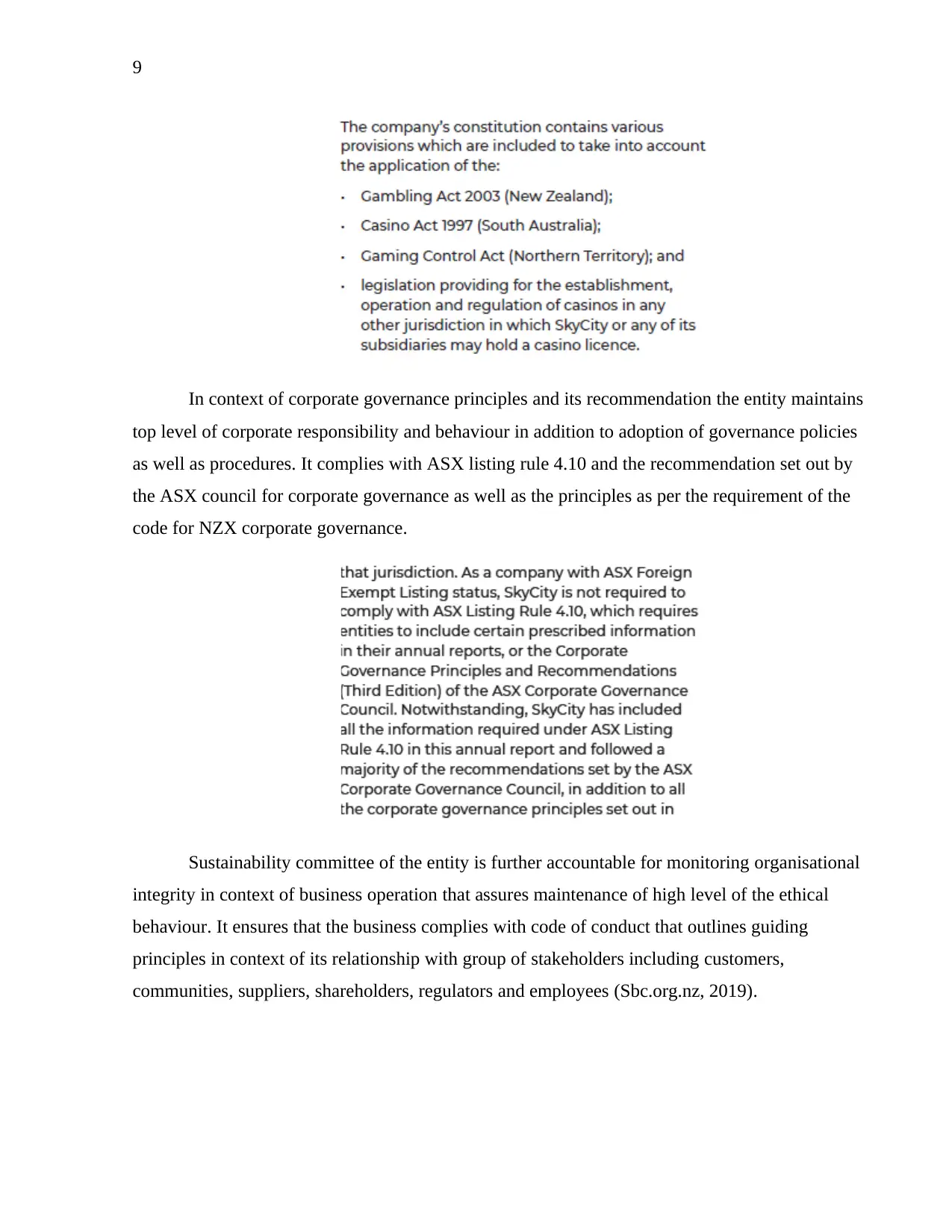
9
In context of corporate governance principles and its recommendation the entity maintains
top level of corporate responsibility and behaviour in addition to adoption of governance policies
as well as procedures. It complies with ASX listing rule 4.10 and the recommendation set out by
the ASX council for corporate governance as well as the principles as per the requirement of the
code for NZX corporate governance.
Sustainability committee of the entity is further accountable for monitoring organisational
integrity in context of business operation that assures maintenance of high level of the ethical
behaviour. It ensures that the business complies with code of conduct that outlines guiding
principles in context of its relationship with group of stakeholders including customers,
communities, suppliers, shareholders, regulators and employees (Sbc.org.nz, 2019).
In context of corporate governance principles and its recommendation the entity maintains
top level of corporate responsibility and behaviour in addition to adoption of governance policies
as well as procedures. It complies with ASX listing rule 4.10 and the recommendation set out by
the ASX council for corporate governance as well as the principles as per the requirement of the
code for NZX corporate governance.
Sustainability committee of the entity is further accountable for monitoring organisational
integrity in context of business operation that assures maintenance of high level of the ethical
behaviour. It ensures that the business complies with code of conduct that outlines guiding
principles in context of its relationship with group of stakeholders including customers,
communities, suppliers, shareholders, regulators and employees (Sbc.org.nz, 2019).
Paraphrase This Document
Need a fresh take? Get an instant paraphrase of this document with our AI Paraphraser
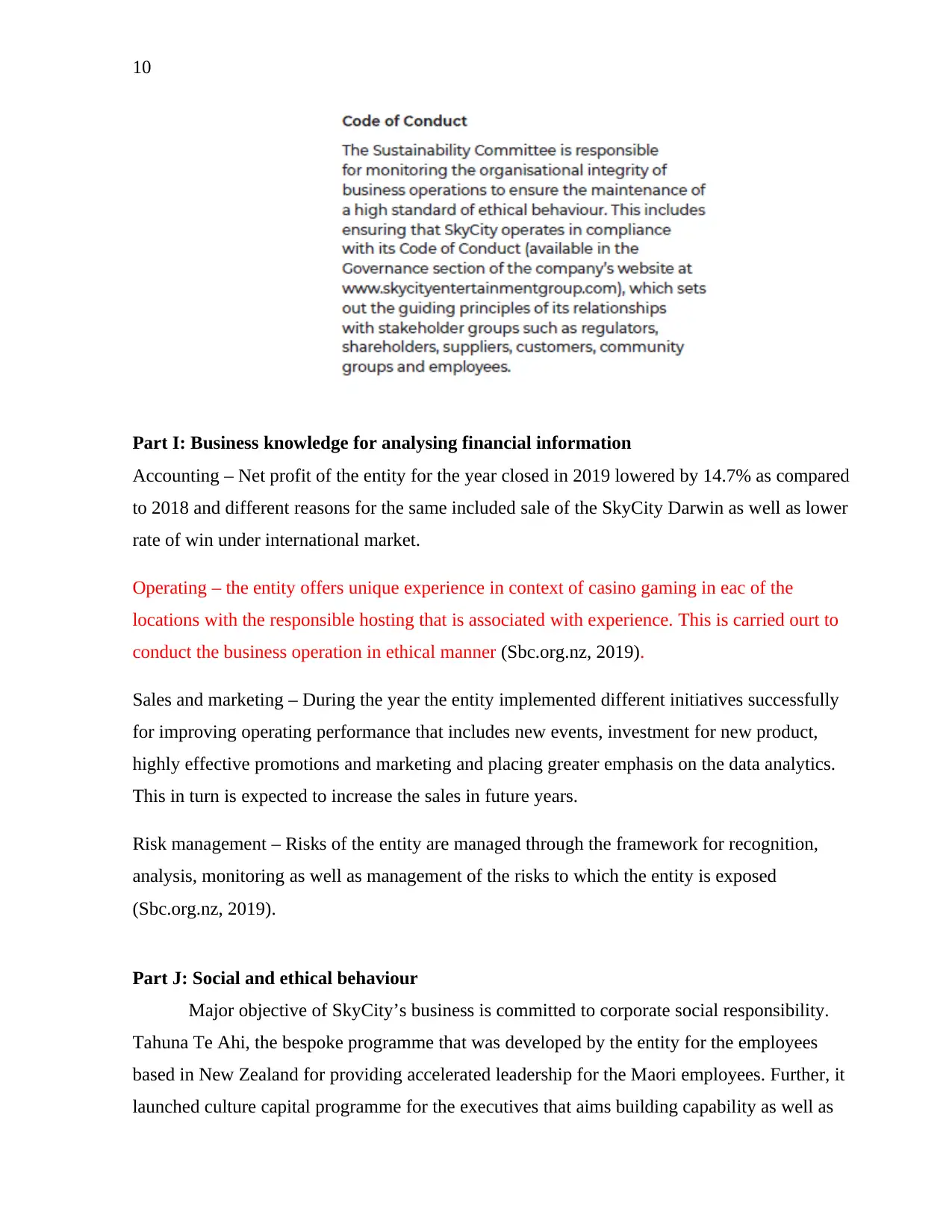
10
Part I: Business knowledge for analysing financial information
Accounting – Net profit of the entity for the year closed in 2019 lowered by 14.7% as compared
to 2018 and different reasons for the same included sale of the SkyCity Darwin as well as lower
rate of win under international market.
Operating – the entity offers unique experience in context of casino gaming in eac of the
locations with the responsible hosting that is associated with experience. This is carried ourt to
conduct the business operation in ethical manner (Sbc.org.nz, 2019).
Sales and marketing – During the year the entity implemented different initiatives successfully
for improving operating performance that includes new events, investment for new product,
highly effective promotions and marketing and placing greater emphasis on the data analytics.
This in turn is expected to increase the sales in future years.
Risk management – Risks of the entity are managed through the framework for recognition,
analysis, monitoring as well as management of the risks to which the entity is exposed
(Sbc.org.nz, 2019).
Part J: Social and ethical behaviour
Major objective of SkyCity’s business is committed to corporate social responsibility.
Tahuna Te Ahi, the bespoke programme that was developed by the entity for the employees
based in New Zealand for providing accelerated leadership for the Maori employees. Further, it
launched culture capital programme for the executives that aims building capability as well as
Part I: Business knowledge for analysing financial information
Accounting – Net profit of the entity for the year closed in 2019 lowered by 14.7% as compared
to 2018 and different reasons for the same included sale of the SkyCity Darwin as well as lower
rate of win under international market.
Operating – the entity offers unique experience in context of casino gaming in eac of the
locations with the responsible hosting that is associated with experience. This is carried ourt to
conduct the business operation in ethical manner (Sbc.org.nz, 2019).
Sales and marketing – During the year the entity implemented different initiatives successfully
for improving operating performance that includes new events, investment for new product,
highly effective promotions and marketing and placing greater emphasis on the data analytics.
This in turn is expected to increase the sales in future years.
Risk management – Risks of the entity are managed through the framework for recognition,
analysis, monitoring as well as management of the risks to which the entity is exposed
(Sbc.org.nz, 2019).
Part J: Social and ethical behaviour
Major objective of SkyCity’s business is committed to corporate social responsibility.
Tahuna Te Ahi, the bespoke programme that was developed by the entity for the employees
based in New Zealand for providing accelerated leadership for the Maori employees. Further, it
launched culture capital programme for the executives that aims building capability as well as
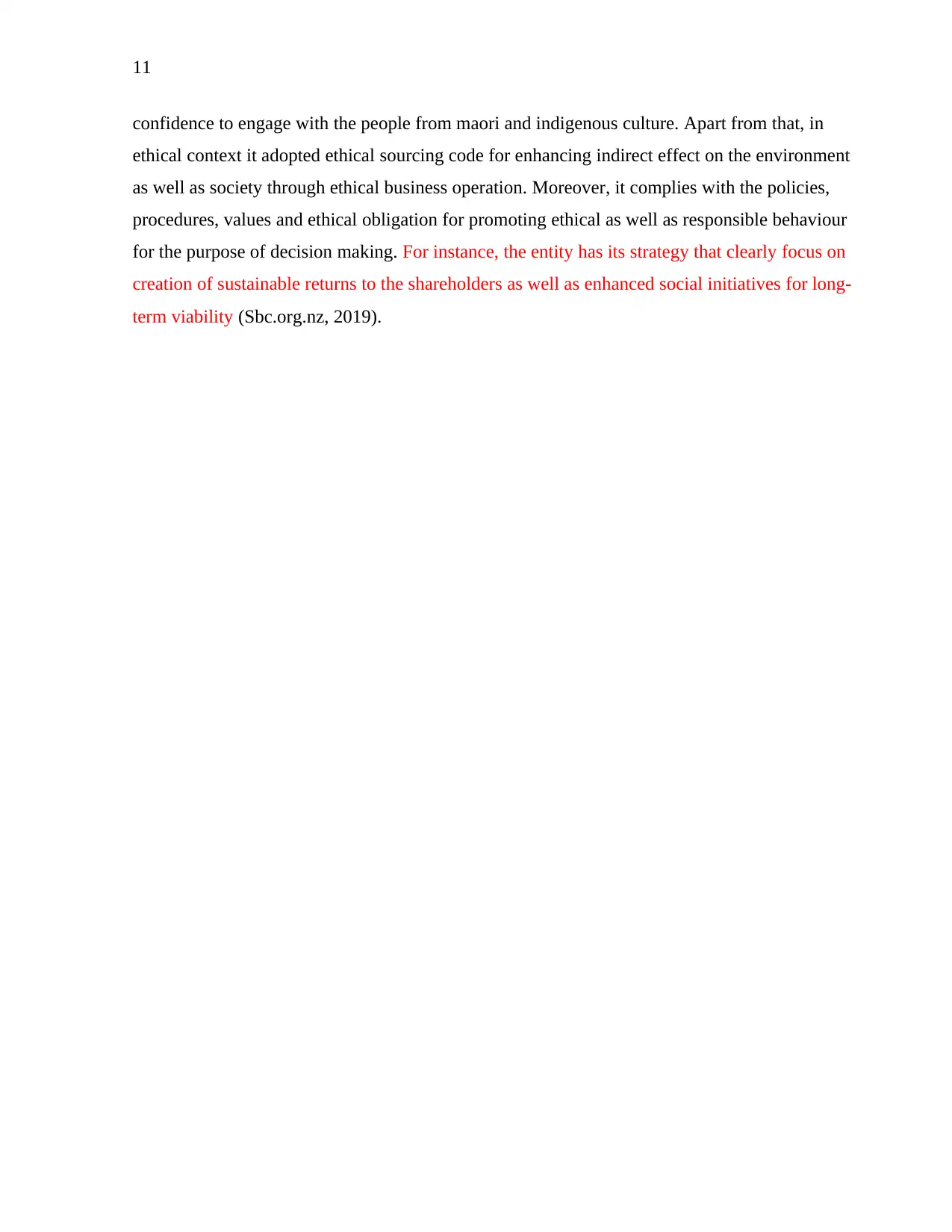
11
confidence to engage with the people from maori and indigenous culture. Apart from that, in
ethical context it adopted ethical sourcing code for enhancing indirect effect on the environment
as well as society through ethical business operation. Moreover, it complies with the policies,
procedures, values and ethical obligation for promoting ethical as well as responsible behaviour
for the purpose of decision making. For instance, the entity has its strategy that clearly focus on
creation of sustainable returns to the shareholders as well as enhanced social initiatives for long-
term viability (Sbc.org.nz, 2019).
confidence to engage with the people from maori and indigenous culture. Apart from that, in
ethical context it adopted ethical sourcing code for enhancing indirect effect on the environment
as well as society through ethical business operation. Moreover, it complies with the policies,
procedures, values and ethical obligation for promoting ethical as well as responsible behaviour
for the purpose of decision making. For instance, the entity has its strategy that clearly focus on
creation of sustainable returns to the shareholders as well as enhanced social initiatives for long-
term viability (Sbc.org.nz, 2019).
⊘ This is a preview!⊘
Do you want full access?
Subscribe today to unlock all pages.

Trusted by 1+ million students worldwide
1 out of 17
Related Documents
Your All-in-One AI-Powered Toolkit for Academic Success.
+13062052269
info@desklib.com
Available 24*7 on WhatsApp / Email
![[object Object]](/_next/static/media/star-bottom.7253800d.svg)
Unlock your academic potential
Copyright © 2020–2025 A2Z Services. All Rights Reserved. Developed and managed by ZUCOL.





